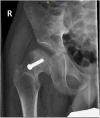Slipped capital femoral epiphysis in a 5-year-old boy with cerebral palsy on valproic acid and levetiracetam for epilepsy: a case report
- PMID: 38370596
- PMCID: PMC10871696
- DOI: 10.1093/jscr/rjae058
Slipped capital femoral epiphysis in a 5-year-old boy with cerebral palsy on valproic acid and levetiracetam for epilepsy: a case report
Abstract
This study presents a rare case of unilateral slipped capital femoral epiphysis treated surgically in a 5-year-old boy with cerebral palsy who was born at 27 weeks' gestation and developed grade III intraventricular haemorrhage and periventricular leucomalacia and was on antiepileptic drugs, including valproic acid and levetiracetam for >3 years. The patient had no history of endocrine, renal, and significant familial diseases.
Keywords: cerebral palsy; hip pain; levetiracetam; slipped capital femoral epiphysis; valproic acid.
Published by Oxford University Press and JSCR Publishing Ltd. © The Author(s) 2024.
Conflict of interest statement
None declared.
Figures








Similar articles
-
[Slipped capital femoral epiphysis in a patient with cerebral palsy due to seizure].Pan Afr Med J. 2018 Oct 5;31:89. doi: 10.11604/pamj.2018.31.89.6832. eCollection 2018. Pan Afr Med J. 2018. PMID: 31011390 Free PMC article. French.
-
Progressive slip after removal of screw fixation in slipped capital femoral epiphysis: two case reports.J Med Case Rep. 2012 Nov 26;6:405. doi: 10.1186/1752-1947-6-405. J Med Case Rep. 2012. PMID: 23181447 Free PMC article.
-
Slipped capital femoral epiphysis in an ambulant patient with spastic cerebral palsy. A long-term evolution.An Sist Sanit Navar. 2020 Aug 31;43(2):261-266. doi: 10.23938/ASSN.0864. An Sist Sanit Navar. 2020. PMID: 32814930
-
[Complications of slipped capital femoral epiphysis].Srp Arh Celok Lek. 2007 Jan-Feb;135(1-2):105-10. Srp Arh Celok Lek. 2007. PMID: 17503578 Review. Serbian.
-
In situ fixation for slipped capital femoral epiphysis: perspectives in 2011.J Bone Joint Surg Am. 2011 May;93 Suppl 2:46-51. doi: 10.2106/JBJS.K.00040. J Bone Joint Surg Am. 2011. PMID: 21543688 Review.
References
Publication types
LinkOut - more resources
Full Text Sources

